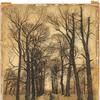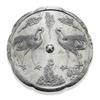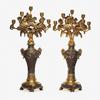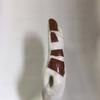'Honoré Sharrer: Claws Sheathed in Velvet' Opens at Hirschl & Adler
- NEW YORK, New York
- /
- April 28, 2019
In today’s politically tense atmosphere, fueled by revelations of corruption, sexual misbehavior, class inequality, simmering racism, and Church reckonings, Honoré Sharrer is having a moment.
Dismissed at various times in her career as a “leftist,” a “housewife,” a “realist,” Sharrer is enjoying a reconsideration by artists, collectors, and curators alike. Linda Nochlin championed her in the final years of Sharrer’s lifetime. Since then, the Museum of Modern Art, New York; The Metropolitan Museum of Art, New York; the Seattle Art Museum, Washington; the Smithsonian American Art Museum, Washington, D.C.; and others have delved into their basements to add examples of her work to their main galleries or themed exhibitions. Today’s fascination with underrecognized women artists, content-driven figuration (Lincoln Kirstein was a friend and supporter), and Surrealist undercurrents have led to an upwelling of affection for this artist.
The first large-scale institutional retrospective devoted to Honoré Sharrer was staged in 2017 at the Columbus Museum of Art, Ohio, the Pennsylvania Academy of the Fine Arts, Philadelphia, and the Smith College Museum of Art, Northampton, Massachusetts. In New York, Hirschl & Adler now continues that momentum with a comprehensive exhibition of its own, bringing a body of her work to a New York audience for the first time in seventeen years. Honoré Sharrer: Claws Sheathed in Velvet runs through June 7th.
With forty paintings and works on paper from the 1970s through the 1990s, the exhibition presents the artist in her mature decades, at the height of her potency as a woman painter calling out the hypocrisy and conformity of patriarchal America. The accompanying catalogue features an original essay by contemporary artist Natalie Frank who compares Sharrer’s empowered point of view with her own uncompromising take on women’s agency in the 21st century. In so doing, Frank places Sharrer at the forefront of one of the most vital currents in contemporary art and culture.
Famously describing her work as “vicious, tender, and meticulous,” Sharrer combined the precision of a Northern Renaissance artist with jarring Surrealist imagery and the biting critique of Goya, Daumier, and George Grosz, all to re-define “realism” as a valid “modern” idiom in the Cold-War era. Sharrer’s major self-portrait, Nursery Rhyme (1971) depicts her as an elegant but powerful woman with a hulking, Michelangelesque forearm protruding from her lace gown. A play on grand-manner portraiture, the theatrical drapery in this instance is little more than a bed sheet hanging on a laundry line, while flies and strewn cigarette butts further undermine any illusions of grandeur. She is attended by a faceless male figure with a bouquet of flowers for a head. Ordinary forks bend and “the dish ran away with the spoon.” Bearing witness to the Surrealist comedy, “a little dog laughed to see such a sport.” The artist, meanwhile, stands coolly circumspect amid the nonsensical, topsy-turvy scene, announcing that in her world all is not what it seems.
Resurrection of the Waitress (1984) focuses on the tragic plight of a working-class woman dead of an overdose. But there will be no tears for this modern-day martyr. Instead, she ascends triumphantly to heaven assisted by an angel with an eggbeater, completing her miraculous transformation from pitiful wretch to feminist and domestic icon.
Afternoon of a Satyr (1989) is classic Sharrer, drawing on mythology to express certain contemporary truths about the absurdity of a male-centric society. Alluding to the shocking eroticism of Vaslav Nijinski’s 1912 ballet, Afternoon of a Faun, this satyr displays his kill unconvincingly atop an aqua-blue Volkswagon Beetle on the verge of careening down a cliff; while his guns–the symbol of his virility–protrude meekly through the car’s cracked window. The nude at left is presumably his gift-wrapped prize. But, as Frank asserts in her essay, this nymph will not be the conquest of his false prowess. She has her boots securely on and the confidence to handle a delicate balancing act. The satyr may not yet realize it, but the ending to this story will be whatever the woman makes it.
In 1949, Mademoiselle Magazine named Honoré Sharrer (1920–2009) “Woman Artist of the Year.” In 1951, she had a solo exhibition at New York’s prestigious Knoedler Gallery, where her five-panel work, Tribute to the American Working People (1946–51; Smithsonian American Art Museum, Washington, D.C.) attracted favorable critical praise and press notice. Indeed, the first baker’s dozen years of Sharrer’s career promised a successful, high profile future. Consistent with her auspicious beginning, Sharrer worked as an artist for the rest of her life, producing a body of accomplished and impressive paintings. But the acclaim faded, done in by a combination of Senator Joseph McCarthy’s wave of repression, by Sharrer’s adherence to figural art in the face of the dominance of abstract expressionism in the 1950s and 1960s, and, of course, by the fact that the artist was a woman. Her budding resurgence is similarly the result of social forces that are now encouraging the reexamination of a neglected body of work and of major talents unfairly ignored.
Hirschl & Adler represents the Estate of Honoré Sharrer.








![Peter Paul Rubens (Flemish, 1577–1640), After Titian (Tiziano Vecelli) (Italian [Venetian], c. 1488–1576), Rape of Europa, 1628–29. Oil on canvas, 71 7/8 x 79 3/8 in. Peter Paul Rubens (Flemish, 1577–1640), After Titian (Tiziano Vecelli) (Italian [Venetian], c. 1488–1576), Rape of Europa, 1628–29. Oil on canvas, 71 7/8 x 79 3/8 in.](/images/c/e2/2e/Jan20_Rape_of_Europa100x100_c.jpg)






